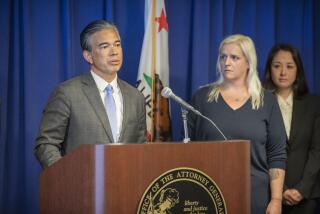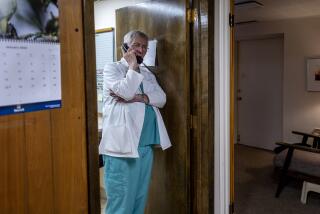Transplant surgeon acquitted
- Share via
Grappling with ethical questions about organ transplants, a San Luis Obispo jury on Thursday acquitted a surgeon accused of trying to speed a potential donor’s death.
The case against Dr. Hootan Roozrokh, believed to be the first of its kind in the United States, was watched intensely by doctors and other professionals involved in transplant surgeries. Experts had feared that a conviction would turn away potential donors, their families and even some of the doctors who harvest organs.
During the two-month trial, Roozrokh was cast by prosecutors as a predator who crossed ethical boundaries in a failed attempt to acquire organs from a dying 25-year-old patient.
The defense contended that Roozrokh acted only with compassion toward Ruben Navarro, a comatose 70-pound man afflicted with a painful, wasting neurological disease.
Jurors found Roozrokh not guilty of dependent adult abuse, a felony that carries a prison sentence of up to four years. In a handwritten note read in court by San Luis Obispo Superior Court Judge Martin Tangeman, the jury said the case highlights the need for well-defined ethical standards in the transplant procedure known as “donation after cardiac death.”
Those standards “will be an important part of Ruben’s legacy, and for that we pay him our respects and owe him our thanks,” the jurors said.
On the night of Feb. 3, 2006, Navarro was close to death at Sierra Vista Regional Medical Center in San Luis Obispo. He had suffered a heart attack days earlier at a nearby care home. His mother had given permission for organ donation, and a team that included Roozrokh flew in from San Francisco on behalf of a regional transplant network.
Roozrokh, who had just completed a Stanford University fellowship months before, was to supervise a donation after cardiac death, a procedure that had never been performed at the 165-bed hospital. In most transplants, the removal of organs occurs only after a patient is declared brain-dead. In donations after cardiac death, a patient’s brain is irreversibly damaged but still functioning minimally. With a family’s consent, the patient is removed from life support and, once the heart has stopped, the patient is declared dead, and organs may be removed minutes later. Many experts say, however, that organs are usable only if they can be retrieved within 30 minutes after the machines are turned off.
According to prosecutors, Roozrokh ordered up excessive doses of the painkiller morphine and Ativan, an anti-anxiety drug, so that Navarro would die within that crucial half-hour. As it turned out, he died eight hours later and Roozrokh did not remove any organs.
“He prescribed drugs with abandon,” Deputy Dist. Atty. Karen Gray said in her closing argument, “drugs that depress respiration and depress blood pressure in a patient who was already hanging by a thread.”
That a transplant surgeon would have anything to do with a potential donor’s care was an appalling breach, Gray said, echoing a concern expressed by many experts in the field. She acknowledged, however, that hospital staff members were unclear about exactly what they should be doing during the unfamiliar procedure.
“Everybody there didn’t know their roles,” Gray told the jury. “That’s why he was able to come in and take charge. They didn’t know enough to stop him -- but he knew better.”
In his testimony, Roozrokh said that the operating room staff was so confused that he had just one ethical choice: Step in to ease what pain and terror Navarro might have been silently experiencing.
He admitted at one point calling the medications “candy,” a joke he said he regretted.
In court, hospital staffers offered differing accounts of how much medication was ordered by Roozrokh, although prosecutors pegged it at 200 milligrams of morphine and 80 milligrams of Ativan in about an hour. Expert witnesses sparred over whether that amount was harmful.
Defense attorney M. Gerald Schwartzbach lashed out at nurses for not keeping proper records, at a transplant coordinator for not clarifying the staff’s responsibilities and at the attending physician, Dr. Laura Lubarsky, for “abdicating her responsibilities” and not ordering pain medications.
Lubarsky, who testified after receiving immunity from prosecutors, said the transplant coordinator had told her that she was only to observe and to declare death when it occurred.
Schwartzbach called the prosecution “shameful.” “It has not made this county or this nation a safer place to live,” he told the jury. “It’s made it a more frightening place to die.”
Roozrokh still faces a hearing before the Medical Board of California.
Although some experts said the highly publicized case reflects deeply held fears about ghoulish transplant physicians, it has not dampened organ donations, according to Bryan Stewart, a spokesman for OneLegacy, the nonprofit organization that secures donations in Los Angeles and six other counties.
“We’ve seen consent rates at hospitals go up and up,” he said. “People realize this is an extremely isolated, completely out-of-the-ordinary case.”
Still, it has underscored flaws in the system, said Arthur Caplan, a University of Pennsylvania ethicist.
“At the end of the day, we’ve got increased pressure for more organs,” he said. “There’s a growing waiting list; there are more centers competing for donors; and it’s a very lucrative procedure for hospitals. It’s against that backdrop that the story of a doctor being sent out to come back with organs unfolds.”
Even before the verdict, the case sent a powerful message.
“It certainly highlighted the potential of extreme problems that could occur without having the proper policies and procedures in place,” said Dr. John Fung, a Cleveland transplant surgeon who testified as a defense witness.
Many hospitals and transplant organizations try to build a wall between medical professionals who care for dying patients and those who are on hand to procure their organs. Transplant teams do not administer medication and sometimes are not allowed in the same room as donors before they die.
But Caplan said he worries about how the rules translate into reality, especially in smaller medical centers.
“Who does what and when is not always clear,” he said. “Are we training hospitals and staffs to know what to do?”
--
More to Read
Sign up for Essential California
The most important California stories and recommendations in your inbox every morning.
You may occasionally receive promotional content from the Los Angeles Times.











